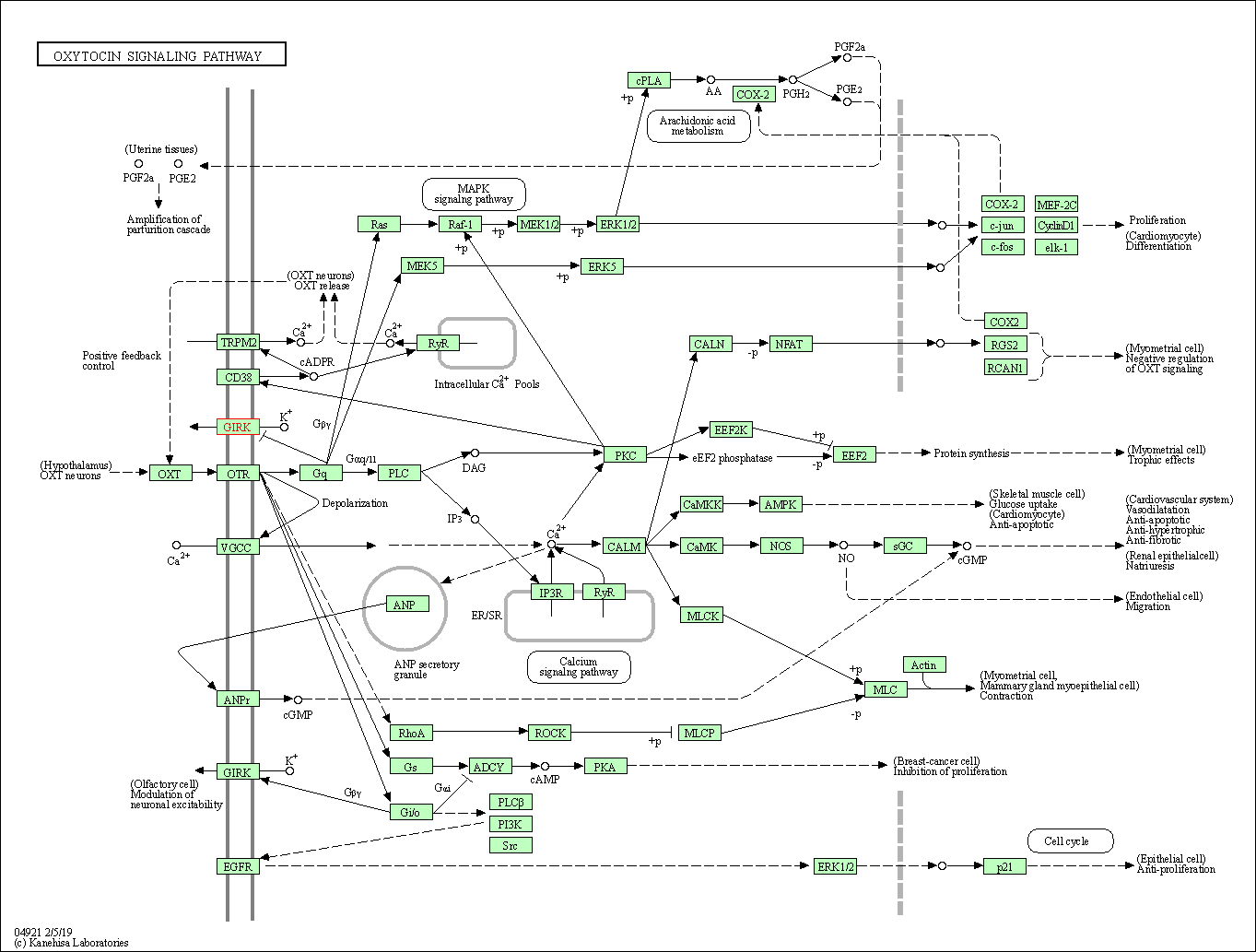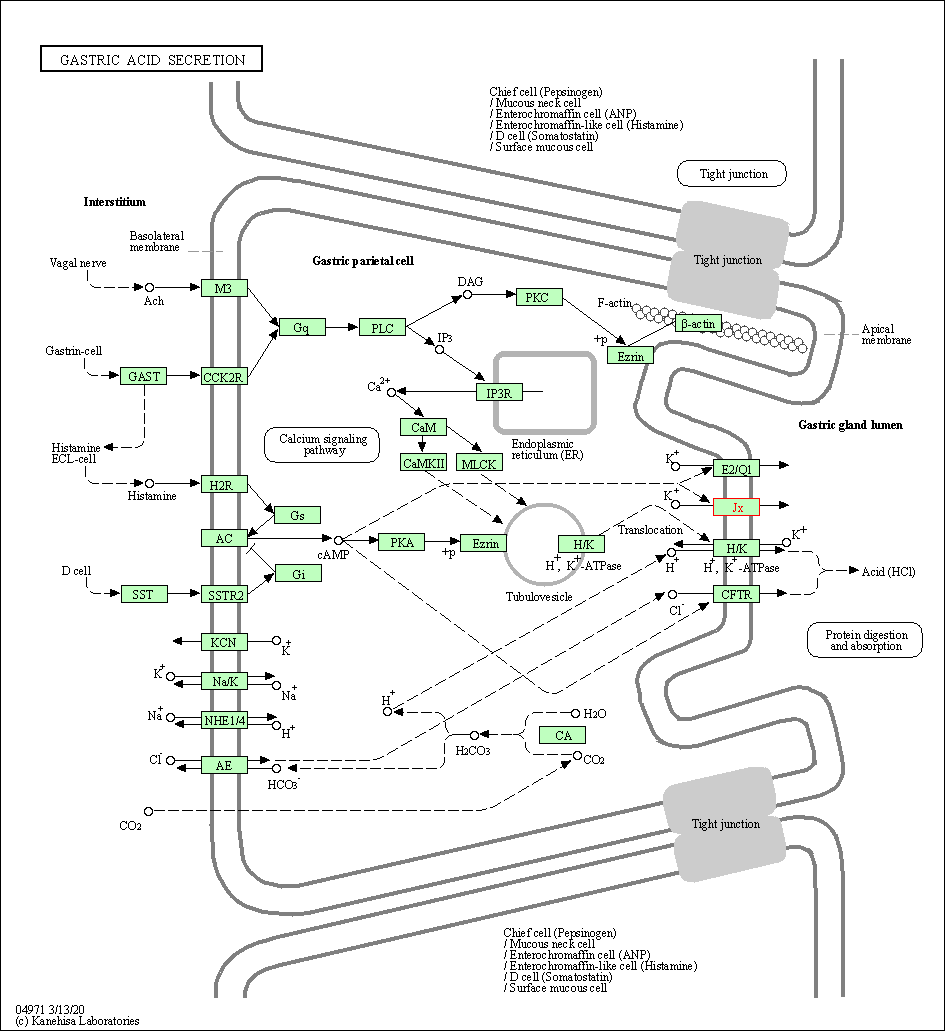Target Information
| Target General Information | Top | |||||
|---|---|---|---|---|---|---|
| Target ID |
T74570
(Former ID: TTDI03315)
|
|||||
| Target Name |
Inward rectifier potassium channel Kir2.1 (KCNJ2)
|
|||||
| Synonyms |
hIRK1; Potassium channel, inwardly rectifying subfamily J member 2; Inward rectifier K(+) channel Kir2.1; IRK1; IRK-1; Cardiac inward rectifier potassium channel
Click to Show/Hide
|
|||||
| Gene Name |
KCNJ2
|
|||||
| Target Type |
Literature-reported target
|
[1] | ||||
| Function |
Inward rectifier potassium channels are characterized by a greater tendency to allow potassium to flow into the cell rather than out of it. Their voltage dependence is regulated by the concentration of extracellular potassium; as external potassium is raised, the voltage range of the channel opening shifts to more positive voltages. The inward rectification is mainly due to the blockage of outward current by internal magnesium. Can be blocked by extracellular barium or cesium. Probably participates in establishing action potential waveform and excitability of neuronal and muscle tissues.
Click to Show/Hide
|
|||||
| BioChemical Class |
Inward rectifier potassium channel
|
|||||
| UniProt ID | ||||||
| Sequence |
MGSVRTNRYSIVSSEEDGMKLATMAVANGFGNGKSKVHTRQQCRSRFVKKDGHCNVQFIN
VGEKGQRYLADIFTTCVDIRWRWMLVIFCLAFVLSWLFFGCVFWLIALLHGDLDASKEGK ACVSEVNSFTAAFLFSIETQTTIGYGFRCVTDECPIAVFMVVFQSIVGCIIDAFIIGAVM AKMAKPKKRNETLVFSHNAVIAMRDGKLCLMWRVGNLRKSHLVEAHVRAQLLKSRITSEG EYIPLDQIDINVGFDSGIDRIFLVSPITIVHEIDEDSPLYDLSKQDIDNADFEIVVILEG MVEATAMTTQCRSSYLANEILWGHRYEPVLFEEKHYYKVDYSRFHKTYEVPNTPLCSARD LAEKKYILSNANSFCYENEVALTSKEEDDSENGVPESTSTDTPPDIDLHNQASVPLEPRP LRRESEI Click to Show/Hide
|
|||||
| 3D Structure | Click to Show 3D Structure of This Target | AlphaFold | ||||
| HIT2.0 ID | T89GCM | |||||
| Cell-based Target Expression Variations | Top | |||||
|---|---|---|---|---|---|---|
| Cell-based Target Expression Variations | ||||||
| Different Human System Profiles of Target | Top |
|---|---|
|
Human Similarity Proteins
of target is determined by comparing the sequence similarity of all human proteins with the target based on BLAST. The similarity proteins for a target are defined as the proteins with E-value < 0.005 and outside the protein families of the target.
A target that has fewer human similarity proteins outside its family is commonly regarded to possess a greater capacity to avoid undesired interactions and thus increase the possibility of finding successful drugs
(Brief Bioinform, 21: 649-662, 2020).
Human Pathway Affiliation
of target is determined by the life-essential pathways provided on KEGG database. The target-affiliated pathways were defined based on the following two criteria (a) the pathways of the studied target should be life-essential for both healthy individuals and patients, and (b) the studied target should occupy an upstream position in the pathways and therefore had the ability to regulate biological function.
Targets involved in a fewer pathways have greater likelihood to be successfully developed, while those associated with more human pathways increase the chance of undesirable interferences with other human processes
(Pharmacol Rev, 58: 259-279, 2006).
Biological Network Descriptors
of target is determined based on a human protein-protein interactions (PPI) network consisting of 9,309 proteins and 52,713 PPIs, which were with a high confidence score of ≥ 0.95 collected from STRING database.
The network properties of targets based on protein-protein interactions (PPIs) have been widely adopted for the assessment of target’s druggability. Proteins with high node degree tend to have a high impact on network function through multiple interactions, while proteins with high betweenness centrality are regarded to be central for communication in interaction networks and regulate the flow of signaling information
(Front Pharmacol, 9, 1245, 2018;
Curr Opin Struct Biol. 44:134-142, 2017).
Human Similarity Proteins
Human Pathway Affiliation
Biological Network Descriptors
|
|
|
There is no similarity protein (E value < 0.005) for this target
|
| KEGG Pathway | Pathway ID | Affiliated Target | Pathway Map |
|---|---|---|---|
| Cholinergic synapse | hsa04725 | Affiliated Target |

|
| Class: Organismal Systems => Nervous system | Pathway Hierarchy | ||
| Oxytocin signaling pathway | hsa04921 | Affiliated Target |

|
| Class: Organismal Systems => Endocrine system | Pathway Hierarchy | ||
| Renin secretion | hsa04924 | Affiliated Target |

|
| Class: Organismal Systems => Endocrine system | Pathway Hierarchy | ||
| Gastric acid secretion | hsa04971 | Affiliated Target |

|
| Class: Organismal Systems => Digestive system | Pathway Hierarchy | ||
| Degree | 1 | Degree centrality | 1.07E-04 | Betweenness centrality | 0.00E+00 |
|---|---|---|---|---|---|
| Closeness centrality | 1.56E-01 | Radiality | 1.22E+01 | Clustering coefficient | 0.00E+00 |
| Neighborhood connectivity | 7.00E+00 | Topological coefficient | 1.00E+00 | Eccentricity | 13 |
| Download | Click to Download the Full PPI Network of This Target | ||||
| Chemical Structure based Activity Landscape of Target | Top |
|---|---|
| Target Poor or Non Binders | Top | |||||
|---|---|---|---|---|---|---|
| Target Poor or Non Binders | ||||||
| Target Regulators | Top | |||||
|---|---|---|---|---|---|---|
| Target-regulating microRNAs | ||||||
| References | Top | |||||
|---|---|---|---|---|---|---|
| REF 1 | Cytoplasmic accumulation of long-chain coenzyme A esters activates KATP and inhibits Kir2.1 channels. J Physiol. 2006 Sep 1;575(Pt 2):433-42. | |||||
| REF 2 | Multiple PIP2 binding sites in Kir2.1 inwardly rectifying potassium channels. FEBS Lett. 2001 Feb 9;490(1-2):49-53. | |||||
If You Find Any Error in Data or Bug in Web Service, Please Kindly Report It to Dr. Zhou and Dr. Zhang.

